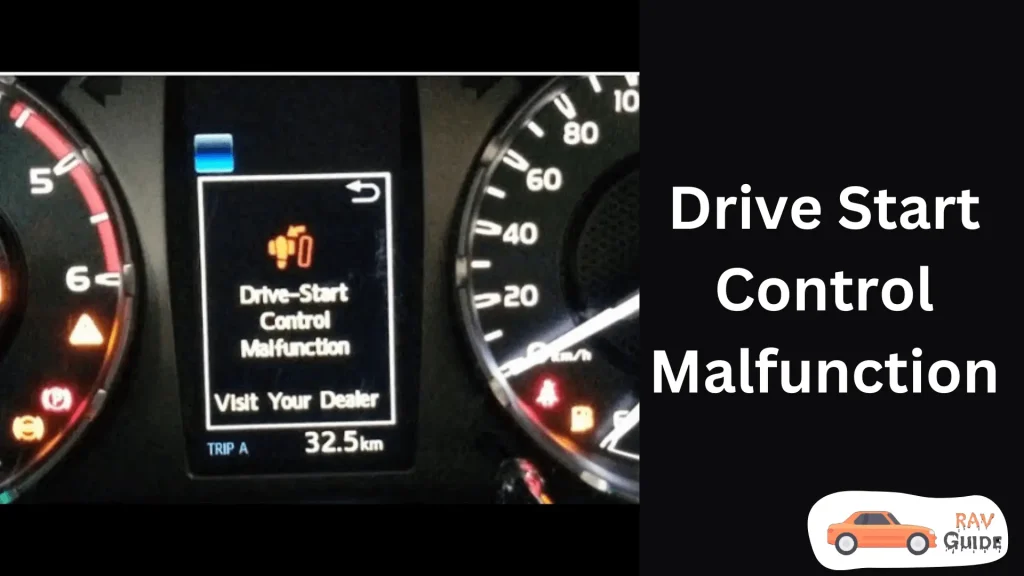Even if you’re pretty savvy about cars, seeing a warning message pop up on your car’s dashboard can be a bit nerve-wracking. It’s like a little alarm bell going off in your head! One of those messages that can make your heart skip a beat is the “Drive Start Control Malfunction” warning on your Toyota.
But hey, don’t worry too much! This guide is here to help you figure out what drive start control malfunction warning means and why it might be showing up on your car. We’ll also explore some cool tricks to fix it, so you can get back to cruising around stress-free. So, buckle up, and let’s dive into the world of car troubleshooting!
What is Toyota Drive Start Control?
Toyota Drive Start Control is like having a watchful guardian in certain Toyota models, ensuring your drives are safe and smooth. This nifty feature is all about preventing unexpected speed-ups, especially when someone accidentally presses the gas pedal too hard. It’s like a safety net, making driving safer by detecting sudden changes and taking quick actions to avoid potential accidents.
Here’s how it works: Imagine the Electronic Control Unit (ECU) as the brain of your car. When it senses something off, like a sudden glitch, it steps in to make sure your car accelerates in a controlled and safe way. It’s like having a responsible friend who nudges you when you’re about to do something unintentional.
So, whether you press the gas pedal a bit too enthusiastically during start-up or maybe mix up the gas and brake pedals, the Drive Start Control has your back. It’s like an extra layer of safety, reducing the chances of accidents caused by unexpected speed-ups or pedal mix-ups. Think of it as a superhero feature in your Toyota that adds an extra level of protection to your driving adventures!
What Does Drive Start Control Malfunction Mean?
In the world of modern Toyota cars, the Drive Start Control Malfunction warning is like a car’s way of talking to you about a potential hiccup. Picture it as your car’s little way of saying, “Hey, something’s not quite right in the system that keeps an eye on how fast we’re going.”
This fancy system is all about making sure things stay smooth when you press the gas or the brake pedal. It’s like having a smart assistant that says, “Hold on, did you mean to hit the gas instead of the brake or the other way around?” It’s there to keep your driving experience safe and sound.
Now, if you see the drive start control malfunction message pop up, it’s like the car telling you, “Oops, we found a glitch in the system.” This glitch could make your car feel a bit off – like it’s not as powerful as usual or even having trouble starting up. You might also notice it acting a bit funny when you try to speed up or feel a bit shaky.
If there’s an issue with another part of the car related to this warning, you might notice some other weird stuff happening too. So, it’s like a car detective looking out for you.
Potential Reasons for this Message
Figuring out exactly what’s causing the hiccup in your car’s system is a bit like solving a mystery. It’s not always easy, but we can explore some common suspects that might be behind the Drive Start Control Malfunction message. Keep in mind, though, that it’s like trying to guess the culprit without a detective – in this case, a skilled Toyota technician – taking a closer look.
Remember, it’s like a car’s way of saying, “I need a checkup!” Therefore, when uncertainty arises, it is advisable to allow automotive specialists to examine the situation and unravel the enigma. You should also know about the Toyota RAV4 Prime tax credit.
Is It OK to Keep Driving?
When your Toyota starts sending out warning messages, it’s like your car’s way of saying, “Hold on, something’s not quite right.” In these situations, it’s really important to pull over and not keep driving until we figure out what’s going on. It’s a bit like taking a break when you’re feeling unwell – you wouldn’t want to make things worse, right?
This Drive Start Control Malfunction message is like a big red flag. It’s telling us that there’s a pretty serious issue under the hood. Imagine if your car is trying to tell you, “I need a doctor, or I might not work properly.” If you ignore it and keep driving, it’s a bit like ignoring your health issues – things could get worse, and it might end up costing more to fix.
In some cases, this error message might even stop your car from starting altogether. It’s like your car saying, “I need a rest before I can get back on the road.” If you ignore this warning and try to start the car anyway, it might decide to take a break at the most inconvenient time, leaving you stuck somewhere far from home.
To play it safe and avoid more problems, it’s a good idea to get your car checked out as soon as possible. It’s like giving your car a visit to the doctor to make sure everything’s okay. So, if you ever see this warning, pull over, turn off the engine, and get some help from a car expert to keep your ride in top shape!
(CARARAC)
How to Fix Drive Start Control Malfunction?
If you’re feeling a bit adventurous and have a knack for fixing things, there are some steps you can take to try and sort out the Drive Start Control Malfunction issue. Think of it like being a car detective, investigating to see if you can crack the case. Here are a few things you can try:
However, if the car puzzle seems too complex, or you’re not confident in your car detective skills, it’s perfectly fine to call in the experts. A Toyota technician is like a superhero with a cape for cars – they know the ins and outs of your vehicle. If the DIY steps don’t do the trick, it’s wise to let the pros take a look and make sure your car gets the care it needs. It’s like having a doctor for your car troubles!
Cost of Fixing the Drive Start Control Malfunction
So, how much might it cost to get your car back in tip-top shape? Well, it’s a bit like asking how much it would cost to fix a broken toy – it depends on what’s wrong. Let’s break it down.
Remember, fixing your car is a bit like investing in its health, and each cost is like a step towards getting it back on the road, ready for new adventures. If you’re ever in doubt, it’s okay to seek advice from the car experts – they’re like the doctors for your four-wheeled friend!
Resetting the Drive Start Control Malfunction in Your Toyota
If you ever find yourself dealing with a pesky Drive Start Control Malfunction in your Toyota, don’t worry – you can try to reset it yourself. It’s like giving your car a little reset button to get things back on track. Here’s how you can do it:
Now, here’s the catch: these steps are like a general guide, and the reset process might vary depending on your specific car model. Think of it as following a recipe – some ingredients may change. For safety reasons, it’s a good idea to reach out to your dealership or consult your car’s manual. If the Drive Start Control is still acting up after your DIY attempt, it might be time to call in the car experts for a closer look. It’s like getting a checkup from a car doctor to make sure everything’s in top-notch condition!
Preventing Drive Start Control Malfunction
Keeping your car’s Drive Start Control system in top shape is a bit like giving it a regular checkup. Here are some simple tips to help you avoid those pesky malfunctions in the future:
Remember, the secret to avoiding drive-start control malfunctions is giving your car some love and attention. Regular checkups, gentle driving, and staying mindful of your car’s limits can go a long way. By following these simple tips, you’re ensuring that your car’s drive start control system keeps humming along, making your rides safe and enjoyable.
Conclusion
In the end, taking good care of your car’s Drive Start Control system is like giving it a reliable compass for smooth journeys. Regular checkups, gentle driving, and keeping an eye on the system’s health can help you avoid unexpected malfunctions. So, treat your car with care, and you’ll enjoy the road ahead without any unexpected bumps.

